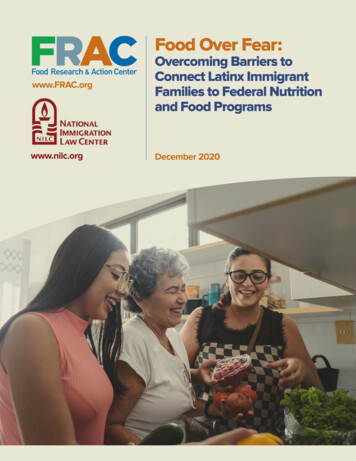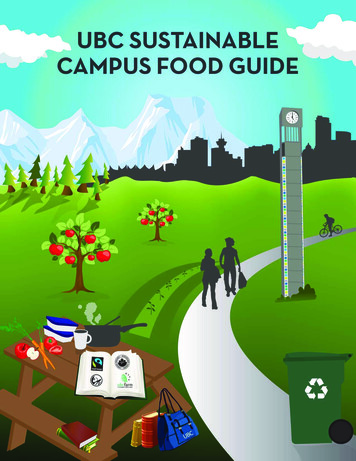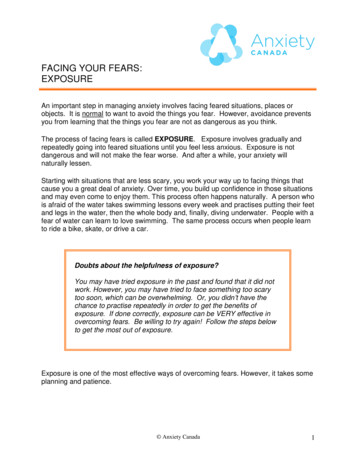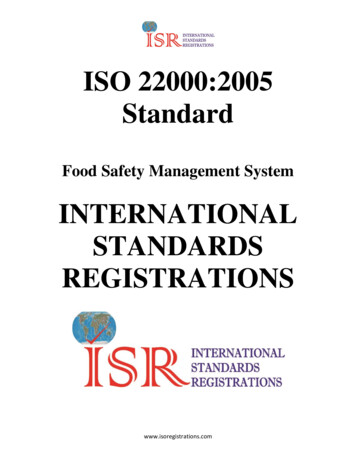
Transcription
Food Over Fear:www.FRAC.orgOvercoming Barriers toConnect Latinx ImmigrantFamilies to Federal Nutritionand Food Programswww.nilc.orgDecember 2020Food Over Fear: Overcoming Barriers to Connect Latinx Immigrant Families to Federal Nutrition and Food Programs1
Food Over Fear:Overcoming Barriers toConnect Latinx ImmigrantFamilies to Federal Nutritionand Food ProgramsFRAC also wishes to thank Bread for the City and D.C.Hunger Solutions for helping conduct a pilot focus groupwith immigrant parents in Washington, D.C.AcknowledgmentsThe Food Research & Action Center (FRAC) gratefullyacknowledges Beacon IA’s support for work to protectthe nutrition and health of immigrant families.FRAC also wishes to acknowledge and thank theimmigrant parents and nutrition service providers whoparticipated in focus groups that took place in NorthwestArkansas; Central Valley California; Denver, Colorado; andChicago, Illinois; from November 2019–January 2020.Their willingness to share their opinions, insights, andstories on the issues of addressing food insecurity amongimmigrant families is the backbone of this report and weare grateful for the trust they placed in us. These focusgroups would not have been possible without the supportof our wonderful state anchors:Arkansasn Arkansas Hunger Relief Alliancen Arkansas UnitedCalifornian Western Center on Law and Poverty (WCLP)n Dolores Huerta FoundationColoradon Hunger Free Coloradon Colorado Immigrant Rights Coalition (CIRC)This report was prepared by Alexandra Ashbrook of FRACand Jackie Vimo of the National Immigration Law Center,with special assistance from FRAC’s Susan Beaudoin onfocus group data analysis, and contributions from LuisGuardia, Crystal FitzSimons, Geri Henchy, andEllen Vollinger (all of whom are from FRAC).About FRACFor 50 years, the Food Research & Action Center (FRAC)has been the leading national organization working formore effective public and private policies to eradicatedomestic hunger and undernutrition. For more informationabout FRAC, or to sign up for FRAC’s Weekly News Digestand monthly newsletters, go to: frac.org.About the NationalImmigration Law CenterEstablished in 1979, the National Immigration LawCenter (NILC) is one of the leading organizations in theU.S. exclusively dedicated to defending and advancingthe rights of immigrants with low income. For moreinformation about NILC and to sign up for email updates,go to: www.nilc.org.Illinoisn Illinois Hunger Coalition (IHC); andn Illinois Coalition for Immigrant andRefugee Rights (ICIRR).Food Over Fear: Overcoming Barriers to Connect Latinx Immigrant Families to Federal Nutrition and Food Programs2
TABLE OF CONTENTSEXECUTIVE SUMMARY.4INTRODUCTION.6FINDINGS.8lImmigrant families are forgoing federal nutrition and food programs that are essentialto improving their food security, nutrition, health, and well-being.8lA range of obstacles impede immigrant families’ access to the federal nutritionand food programs. 12WHAT FOCUS GROUP PARTICIPANTS SAID.17RECOMMENDATIONS. 18lProvide accurate information on immigration-related issues that intersect with the abilityto access federal nutrition and food programs. 18lEnlist trusted messengers in crafting and disseminating information, including assisting withapplications, to connect immigrant families to available federal nutrition and food programs. 19lImplement, publicize, and monitor existing policies that help immigrants feel safer whenseeking federal nutrition and food program assistance.20lPromote policies and procedures to improve access for immigrant families tofederal nutrition and food programs. 21lAdvocate for new policies and programs to help more immigrants address food insecurity.22CONCLUSION.23APPENDIX.24Food Over Fear: Overcoming Barriers to Connect Latinx Immigrant Families to Federal Nutrition and Food Programs3
EXECUTIVE SUMMARYThis report sheds light on why many immigrantfamilies are forgoing vital assistance fromfederal nutrition and food programs and lifts uprecommendations aimed at ensuring that all families andindividuals, regardless of immigration status, are nourishedand healthy.While the findings of this report are informed by a seriesof focus groups conducted from November 2019–January2020 (prior to the onset of COVID-19), the need to connectimmigrant families to nutrition programs is arguably ofeven greater importance given how COVID-19 is fuelingunprecedented food insecurity and ravaging communitiesof color and immigrant communities at disproportionatelyhigh rates due to unique barriers faced by families thatinclude noncitizens.The focus groups that were conducted by the FoodResearch & Action Center and the National ImmigrationLaw Center, in partnership with state anti-hunger andimmigrant rights groups, took place with 64 Spanishspeaking immigrant parents in mixed-status families and41 nutrition service providers in four locations: Arkansas(Northwest), California (Central Valley), Colorado (Denver),and Illinois (Chicago). Participants were queried aboutopportunities and obstacles in accessing federal nutritionand food programs, with a focus on the SupplementalNutrition Assistance Program (SNAP), school meals, theSpecial Supplemental Nutrition Program for Women,Infants, and Children (WIC), and emergency food.“The culture of fear is a huge barrier.”— NUTRITION SERVICE PROVIDER, CENTRAL VALLEY CALIFORNIAtest. For the first time ever, the new rule requires that DHSconsider the use of non-cash benefits, such as SNAP by anindividual, as a factor in a public charge determination.The anticipation of the rule accelerated existing fear andconfusion among focus group immigrant families regardingparticipation in federal nutrition and food programs. It alsocontributed to a “chilling effect” on participation in SNAPand other vital nutrition programs by eligible immigrantsand their family members. This “chilling effect” extendedfar beyond the very limited number of noncitizens whoare eligible for SNAP and subject to a DHS public chargedetermination. It also extended to participation in programsthat are not included in public charge determinations, suchas WIC and school meals.One of the most significant findings revealed by thefocus groups’ participants was that immigrant familiesare forgoing federal nutrition and food programs that areessential to improving their food security, nutrition, health,and well-being; SNAP is the most often avoided. Otherfindings are as follows:n Three-quarters of the immigrant parents whoparticipated in the focus groups screened positive forfood insecurity.Data and findings presented in this report from thefocus groups are not intended to be representative ofthe experience of all immigrants in the U.S. Instead, itpresents information on the experiences, opinions, andrecommendations reported by the focus group participants.n More than one-quarter of immigrant parents who wereThe focus groups were conducted, in part, to gauge theimpact of the impending February 2020 implementation ofthe Trump administration’s change in the U.S. Departmentof Homeland Security (DHS) public charge rule. The newrule makes it harder for certain immigrants to obtain LawfulPermanent Resident (LPR) status (i.e., a green card). Inessence, the revised public charge rule imposes a wealthn Even when families are eligible for programs and facesurveyed reported that they stopped using SNAPor other food programs in the last two years due toimmigration-related concerns, and this pattern wasechoed by nutrition service providers.no public charge concerns, many forgo assistance fromthe federal nutrition and food programs.n While immigrant families expressed more fear aboutaccessing SNAP than other federal nutrition and foodprograms, there are still concerns about participating in suchprograms, e.g., school meals, WIC, or emergency food.Food Over Fear: Overcoming Barriers to Connect Latinx Immigrant Families to Federal Nutrition and Food Programs4
n Immigrant parents were more willing to access SNAPand WIC for their children than apply for the adults inthe family, and to sacrifice their own nutrition for theirchildren’s health.n Immigrant families are more likely to apply forMedicaid than SNAP.to federal nutrition and food programs. These insights areintended to provide organizations that support immigrantfamilies with ideas and guidance on how to overcomebarriers so that immigrant families can feel comfortableaccessing vital nutrition programs. Their recommendationsare as follows:Another major finding is that a range of obstacles impedeimmigrant families’ access to federal nutrition and foodprograms. Other obstacles cited are as follows:n provide accurate information on immigration-relatedn Immigrant families are afraid to participate inn enlist trusted messengers to craft and disseminatefederal nutrition and food programs due to multipleimmigration-related concerns.n Immigrant families are not always familiar with the term“public charge,” despite expressing fears associatedwith the rule.n Information that immigrant families receive aboutthe public charge rule through some traditional anddigital media outlets and immigration attorneys isoften inaccurate. Immigrants also expressed lowlevels of trust of the accuracy of media reportingon public charge.n Immigrant families often face language barriers anddiscrimination when accessing federal nutrition andfood programs.n Immigrant families worry that personal informationthey submit when applying for federal nutrition andfood programs will be shared with immigrationenforcement agencies.n Immigrant families and nutrition service providers lackinformation about available federal nutrition and foodprograms, citing confusion about immigrant households’SNAP eligibility.n Transportation barriers to access federal nutritionand food programs disproportionately affectimmigrant families due to fears of being out inpublic and vulnerable to attacks by immigrationenforcement agencies.Based on analysis of data compiled from the immigrantparent and nutrition service provider focus groups, thisreport concludes with recommendations and opportunitiesto overcome challenges and to connect immigrant familiesissues that intersect with the ability to access federalnutrition and food programs;information, as well as to assist with applications, inorder to connect immigrant families to available federalnutrition and food programs;n implement, publicize, and monitor existing policiesthat help immigrants feel safer when seeking federalnutrition and food program assistance;n promote policies and procedures to improve access forimmigrant families to SNAP and other federal nutritionand food programs; andn advocate for new policies and programs to help moreimmigrants address food insecurity.This report reinforces how a range of attacks on immigrantfamilies — including the public charge rule — have createdan environment of heightened fear and confusion thatis impeding access to the very programs that can helpimmigrants thrive. In addition to hostile governmentalactions, immigrants also face barriers, some are unique toimmigrants while others are also faced by non-immigrants,that can make it more challenging to access programs.These barriers include a lack of information on the rangeof available nutrition programs, confusing rules regardingnoncitizen eligibility, transportation issues, distrust ofgovernment agencies, and language access. Supportingimmigrants’ access to federal nutrition and food programsis essential to addressing food insecurity and boostinghealth, achievement, economic security, and opportunityfor everyone, as we are all healthier and stronger wheneveryone in our communities has access to the food andnutrition they need. The recommendations derived fromthe focus groups data illustrate that we all have a role toplay in ensuring that every low-income person and familycan access these vital programs.Food Over Fear: Overcoming Barriers to Connect Latinx Immigrant Families to Federal Nutrition and Food Programs5
INTRODUCTIONBefore the COVID-19 pandemic began, immigrantfamilies — even families with U.S. citizen members— faced disproportionate obstacles to accessingfederal nutrition and food programs that protect againstfood insecurity. Now with COVID-19 fueling unprecedentedfood insecurity and ravaging immigrant communities atdisproportionate rates, the work to connect immigrantfamilies to nutrition programs that keep them nourishedand healthy is of utmost importance.This report examines the unique barriers that immigrantfamilies face in accessing federal nutrition and foodprograms and identifies possible solutions to ensure thatall families and individuals, regardless of immigration status,are nourished and healthy during the COVID-19 pandemicand beyond.The Food Research & Action Center and the NationalImmigration Law Center, in partnership with state anti-hunger and immigrant rights organizations, conducted aseries of focus groups and surveys with immigrant parentsand nutrition program service providers in Arkansas(Northwest), California (Central Valley), Colorado (Denver),and Illinois (Chicago) from November 2019–January 2020,to undertake the following:n explore how immigrant-related concerns areaffecting participation in federal nutrition and foodprograms, with a focus on the Supplemental NutritionAssistance Program (SNAP), school meals, the SpecialSupplemental Nutrition Program for Women, Infants,and Children (WIC), and emergency food;n shed light on the unique obstacles that immigrantfamilies face in order to access federal nutrition andfood programs; andn lift up the focus groups’ recommendations onopportunities to connect immigrant families to thesecritical programs.Research NotesFor purposes of this report, the term “immigrant” familyrefers to a household that includes at least one memberborn outside of the U.S. This report’s findings are basedon focus groups with immigrants who were born incountries where Spanish is a central language, primarilyMexico; and nutrition service providers who work mostlywith immigrant families that include Spanish-speakingmembers. The findings, while potentially applicable to abroader cross-section of immigrant families, are basedon the experiences, opinions, and ideas of these focusgroup participants.Focus GroupsThe Food Research & Action Center and the NationalImmigration Law Center facilitated a total of eight focusgroups. Each state held two focus groups.n A focus group of immigrant parents in each ofthe four states: In total, 64 non-U.S. citizen parentswho were born in a Spanish-speaking country andlikely met the income criteria to be eligible for theSupplemental Nutrition Assistance Program (SNAP)participated in the groups across the four states.Most had children who were U.S. citizens. Focusgroup sessions were facilitated in Spanish.n A focus group of nutrition service providers in eachof the four states: In total, 41 participants whose jobresponsibilities included familiarity with connectingimmigrant families to SNAP and other federalnutrition or food programs participated in the groupsacross the four states.Prior to the start of each of the 60–90-minute focusgroup discussions, most of the focus groups’ participantscompleted a written survey; however, not every participantcompleted each question. A few focus group participantsarrived too late and did not complete the survey.See Appendix for more details.Food Over Fear: Overcoming Barriers to Connect Latinx Immigrant Families to Federal Nutrition and Food Programs6
“For the government to say that we are a burden is a vile and vulgarlie. And I can say that and shout to the four winds. No one can tellme that I have been a burden on the United States. On the contrary,I have done work where no one has been able to do it.I have not been a burden.”— IMMIGRANT PARENT, NORTHWEST ARKANSASData and analysis presented in this report are not intendedto be representative, but instead present information on theexperiences, opinions, and recommendations reported byfocus group participants.The federal nutrition and food programs reach tens ofmillions of people, including millions of immigrants, eachyear. The programs play a critical role in reducing foodinsecurity and in improving the health and economicsecurity of individuals, households, communities, and theentire nation.Immigrants, especially children, are often eligible for andcan benefit from many federal nutrition and food programs.Child nutrition programs (e.g., school meals, summer andafterschool meals, and WIC) and food bank-distributedcommodities are generally available to all categoriesof low-income people. SNAP has more restrictive andcomplicated requirements for noncitizens. Nonetheless,many members of immigrant households are eligible forSNAP, including U.S. citizen children, even if their parentsare not themselves eligible; refugees; asylees; children whoare Lawful Permanent Residents (LPRs); and LPR adultswho have been in the U.S. for at least five years.While conducted prior to COVID-19, this research providesinsights as to why too many immigrants were alreadyforgoing crucial federal nutrition and food programs.Analysis of the data from research participants alsoprovides recommendations for how to ensure that eligibleimmigrants can access nutrition programs that are critical totheir health and well-being.“I think that nutrition for children is very important because theirbrain is developing, and if they are not getting the necessarynutrients, they are not going to learn in school, they arenot going to feel good. That’s my opinion.”— IMMIGRANT PARENT, CHICAGO, ILLINOISFood Over Fear: Overcoming Barriers to Connect Latinx Immigrant Families to Federal Nutrition and Food Programs7
FINDINGS1. Immigrant families are forgoing federal nutrition and food programs that areessential to improving their food security, nutrition, health, and well-being.Three-quarters of the immigrant parents who participated in the focus groups screened positivefor food insecurity.A person screens positive for food insecurity if the response is “often true” or “sometimes true” to either or both of thesestatements: “Within the past 12 months, we worried whether our food would run out before we got money to buy more;”and “Within the past 12 months, the food we bought just didn’t last and we didn’t have money to get more.” This finding isbased on the validated Hunger Vital Sign screening tool.TABLE A*Immigrant Parent SurveyWithin the past 12 months, we worried whether our foodwould run out before we got money to buy morePercentage oftotal responsesOften true21%Sometimes true59%Never true21%} 79%Total number of respondents: 58*Due to rounding, totals in the table may not add up to 100 percent.TABLE BImmigrant Parent SurveyWithin the past 12 months, the food we bought just didn’tlast and we didn’t have money to get morePercentage oftotal responsesOften true27%Sometimes true48%Never true25%} 75%Total number of respondents: 60More than one-quarter of immigrant parents who were surveyed reported that they stopped usingthe Supplemental Nutrition Assistance Program (SNAP) or other food programs in the last two years;this was due to immigration-related concerns, and was echoed by nutrition service providers.Of the immigrant parents who were surveyed, 27 percent reported that they stopped using SNAP or other food programsin the last two years.Food Over Fear: Overcoming Barriers to Connect Latinx Immigrant Families to Federal Nutrition and Food Programs8
Women, Infants, and Children (WIC), and emergency food,which carry no public charge considerations.TABLE CImmigrant Parent SurveyYes27%No58%Of the nutrition service providers who were surveyed,70 percent either strongly agreed or agreed with thisstatement: “Immigrant families who are eligible forfederal nutrition programs but do not face public chargeconsequences are forgoing nutrition benefits because ofpublic charge fears.”Unsure15%CHART 1Have you or your family stopped usingSNAP or other food programs in thelast two years because of immigrationconcerns?Percentageof totalresponsesTotal number of respondents: 55An immigrant parent in Colorado provided the followinginsight as to how immigration concerns caused their familyto stop participating in SNAP: “As you said about stamps,I don’t receive it, don’t take it, because I’m afraid of mystatus, and just like me, there are many people who don’tuse it. That’s why I stopped [taking] it, because I’m scared.”Likewise, nutrition service providers shared examples offamilies disenrolling or not applying for federal nutrition andfood programs because of immigration-related concerns.For instance, a provider in California stated, “Our partnersare telling us scary stories of people who are forgoingbenefits because they’re afraid. I think the frequency ofthese stories has increased and that’s what leads me tobelieve that there might be more [food insecurity].”Even when families are eligible for programsand face no public charge concerns, manyforgo assistance from federal nutrition and foodprograms.Immigrant parents and nutrition service providerscommented that the public charge rule was complex.Many of them also said that information about whetheraccessing a particular federal nutrition and food programbenefit would carry public charge considerations was notclear. As a result, there were multiple reported instancesof immigrant families not accessing SNAP, even when thepublic charge rule did not apply, as well as not accessingother federal nutrition and food programs, like schoolmeals, the Special Supplemental Nutrition Program forNutrition Service Provider SurveyImmigrant families who are eligible for nutritionprograms but do not face public chargeconsequences are forgoing nutrition benefitsbecause of public charge fears (n 34) Strongly agree 29% Agree 41% Neither agreenor disagree 6% Disagree 3% Strongly disagree 0% Do not know 21%Nutrition service providers repeatedly shared how evenwhen immigrant families were eligible for programs,like SNAP, and faced no public charge concerns, manyfamilies would opt to forgo assistance. In Colorado, aprovider stated, “. we’re seeing that chilling effect of feartrickle into people who might not be impacted by publiccharge whatsoever [e.g., people with asylum or TemporaryProtected Status (TPS)].”While immigrant families expressed morefear about accessing SNAP than other federalnutrition and food programs, there are stillconcerns about participating in such programs,e.g., school meals, WIC, or emergency food.Immigrant families indicated a greater willingness to applyfor WIC for themselves or their partners than for SNAP.Even so, for both programs, immigrant parents surveyedFood Over Fear: Overcoming Barriers to Connect Latinx Immigrant Families to Federal Nutrition and Food Programs9
indicated that they would not apply even when eligible:nearly 27 percent would not apply for SNAP, and a littlemore than 9 percent would not apply for WIC.TABLE DImmigrant Parent SurveyIf you were eligible for SNAP, wouldyou apply?Percentageof totalresponsesYes54%No27%Unsure19%Total number of respondents: 52According to nutrition service providers, SNAP was thefederal nutrition program that immigrant families weremost afraid to access. Other nutrition programs, suchas emergency food, school meals, and WIC, were alsoperceived as programs that immigrant families were afraidto access, though to a lesser extent. A WIC provider inColorado shared how this fear affected participation inWIC: “We have seen a case-drop with our clients. I wouldsay also they were very specific when they called in tohave their case closed . [They said] ‘I don’t want to be [a]public charge.’”CHART 3Nutrition Service Provider SurveyImmigrant Parent SurveyIf you or your partner were pregnantand eligible for WIC, would you apply?Percentageof totalresponsesYes84%No9%Unsure7%Percentage (%) of respondentswho agree or strongly agreeTABLE EImmigrant families in my communityare afraid to access nutrition programs(n 37)908070605040302010078%43%27%SNAPTotal number of respondents: 55WIC30%SchoolMealsEmergencyFoodEven when it came to applying for children who wereeligible for federal nutrition and food programs, immigrantparents reported that they would sometimes forgoassistance, with SNAP topping the list of nutrition programsthey were least likely to apply for.Focus group discussions among immigrant parentsand nutrition service providers offered insights into whyparticipants felt there was a greater risk applying forSNAP than other federal nutrition and food programs.Immigrants were likely to view emergency food as a churchor community program, not as a federal program, so theyCHART 2felt safer accessing it in certain situations.Immigrant Parent SurveyHowever, immigrant parents did shareexamples of discomfort when completing theIf your child was eligible would you apply?application or answering questions in order toPercentage (%) of responsesaccess emergency 9%90%13%20% SNAP (n 55) WIC (n 55) School Meals (n 60)Many immigrants noted that WIC was viewedas a health program instead of a governmentprogram because it is administered by healthclinics. Participants also lifted up how itwas seen as a program that helps children.Participants generally were more comfortablewith programs geared toward meetingchildren’s needs. An immigrant parent inFood Over Fear: Overcoming Barriers to Connect Latinx Immigrant Families to Federal Nutrition and Food Programs10
Likewise, school meals were typically viewed as a schoolprogram. In contrast, SNAP was often viewed as agovernment program that carried negative immigrationconsequences.A key factor underlying the willingness of immigrant familiesto apply for other federal nutrition and food programs overSNAP is how applying for SNAP is perceived to be muchmore onerous than applying for WIC, school meals, oremergency food. An immigrant parent in California said that“WIC doesn’t ask you to report and report. I think once ayear they ask you to present proof of income.”Immigrant parents were more willing to accessSNAP and WIC for their children than apply forthe adults in the family, and to sacrifice their ownnutrition for their children’s health.A theme echoed by immigrant families and nutrition serviceproviders was the willingness of immigrant parents tosacrifice their own nutrition to protect their children fromhunger and to overcome fears about program access if theprograms were for their children. A Northwest Arkansasimmigrant parent put it this way: “[A]s we said in WIC, the[food] stamps are for children. For adults I would not ask .”CHART 4Immigrant Parent SurveyWould you apply for SNAP if eligible?Percentage (%) of responses8067%706054%504027%302013%100Yes For self (n 52)No19% 20%Unsure For children (n 55)CHART 5Immigrant Parent SurveyWould you apply for WIC if eligible?1009080Percentage (%) of responsesCalifornia described WIC as “very different because peoplesay that everyone feels comfortable going to apply forWIC because it’s food for the kids, for their juice, milk. Andpeople see it as a good thing.”84%89%7060504030209%100YesNo For self/partner (n 52)7%7%4%Unsure For children (n 55)Immigrant parents shared actions they took to ensure thattheir children were able to get sufficient food, with manyof the examples highlighting how parents would sacrificetheir own nutrition for their children. Several mothersreported that they would make sure their children were fedbefore they would eat or that they would eat less healthyor consume less so that their children could eat morenutritious foods.Immigrant families are more likely to apply forMedicaid than SNAP.Nutrition service providers and immigrant families voicedfears related to accessing Medicaid, citing public chargeand other immigration concerns as drivers; however,families and nutrition service providers indicated thateligible immigrants were more willing and likely to accessMedicaid over SNAP. A common reason given was thathealth insurance was irreplaceable because it was thegateway to medical care. While a parent could applycoping strategies to put food on the table, such as eatingless so a child could eat, restrict
Arkansas n Arkansas Hunger Relief Alliance n Arkansas United California n Western Center on Law and Poverty (WCLP) n Dolores Huerta Foundation Colorado n Hunger Free Colorado n Colorado Immigrant Rights Coalition (CIRC) Illinois n Illinois Hunger Coalition (IHC); and n Ill











